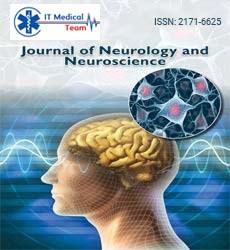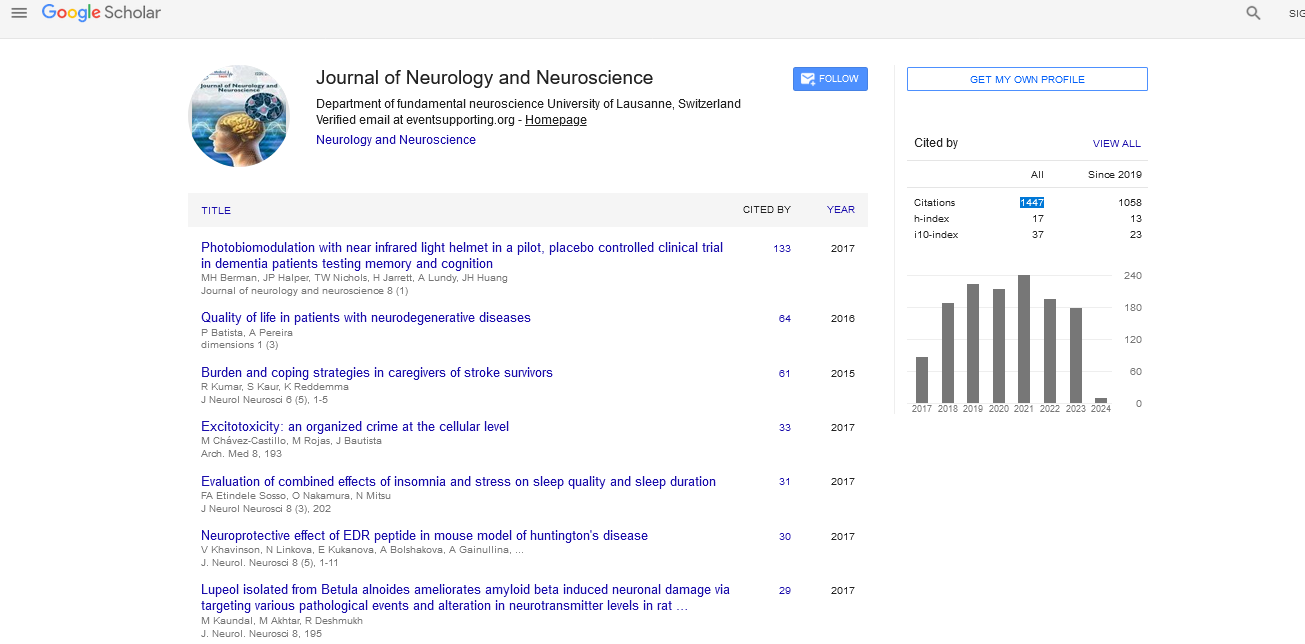Commentary - (2024) Volume 15, Issue 5
Neuromodulation and mental health exploring new frontiers in treatment
Wojciech Smuczyński*
Department of Physiotherapy, Nicolas Copernicus University in Toruń, Techników 3, 85-801 Bydgoszcz, Poland
*Correspondence:
Wojciech Smuczyński, Department of Physiotherapy, Nicolas Copernicus University in Toruń, Techników 3, 85-801 Bydgoszcz,
Poland,
Email:
Received: 03-Oct-2024, Manuscript No. ipjnn-24-15390;
Editor assigned: 05-Oct-2024, Pre QC No. P-15390;
Reviewed: 18-Oct-2024, QC No. Q-15390;
Revised: 24-Oct-2024, Manuscript No. R-15390;
Published:
31-Oct-2024
Introduction
The landscape of mental health treatment is rapidly
evolving, propelled by advancements in neuroscience
and technology. Among the most promising areas
of innovation is neuromodulation-a term that refers
to the use of various methods to alter nerve activity
through targeted delivery of electrical stimulation or
pharmaceutical agents. Neuromodulation techniques have
gained significant traction in recent years, offering hope
for patients with mental health disorders that are resistant
to traditional treatments. This article explores the various
neuromodulation approaches, their applications in mental
health, and the future directions of this exciting field.
Neuromodulation encompasses a range of therapeutic
interventions aimed at modifying the activity of the
nervous system. Transcranial Magnetic Stimulation
(TMS): A non-invasive technique that uses magnetic fields
to stimulate nerve cells in the brain. TMS has been shown
to be effective in treating depression, anxiety disorders,
and PTSD. Deep Brain Stimulation (DBS) involves the
implantation of electrodes in specific brain regions to
modulate neural activity. DBS has been used primarily for
movement disorders but is gaining attention for its potential
in treating severe depression and Obsessive-Compulsive
Disorder (OCD). Vagus Nerve Stimulation (VNS) a device
implanted under the skin that sends electrical impulses
to the vagus nerve, influencing mood and anxiety levels.
VNS is FDA-approved for treatment-resistant depression.
Cranial Electrotherapy Stimulation (CES) a non-invasive
method that uses small electrical currents to stimulate the
brain, often used for anxiety and sleep disorders [1].
Pharmacological Modulation: Involves the use
of medications that target specific neurotransmitter
systems, such as serotonin and dopamine, to alter mood
and cognition. Each of these techniques operates on the
principle that modulating specific neural circuits can lead
to improvements in mood, cognition, and overall mental
health. The efficacy of neuromodulation techniques
stems from our understanding of brain circuits and
neuroplasticity—the brain's ability to reorganize itself by
forming new neural connections. Mental health disorders
are often linked to dysregulation in specific brain areas,
such as the prefrontal cortex, amygdala, and hippocampus.
By targeting these areas with neuromodulation techniques,
clinicians can promote healthier brain function and
alleviate symptoms [2].
For instance, TMS has been shown to increase cortical excitability in the prefrontal cortex, which is often
underactive in depressed individuals. By stimulating this
region, TMS can enhance mood and cognitive function.
Similarly, DBS can modulate hyperactivity in the
subthalamic nucleus, a region implicated in OCD, leading
to a reduction in compulsive behaviors. Major Depressive
Disorder (MDD) affects millions worldwide and is often
resistant to conventional treatments, such as psychotherapy
and pharmacotherapy. Neuromodulation has emerged as a
viable alternative for treatment-resistant depression [3].
Description
TMS has been FDA-approved for MDD since 2008
and has demonstrated significant efficacy in clinical trials.
Studies indicate that TMS can lead to rapid improvements
in depressive symptoms, with effects lasting several months
post-treatment. Its non-invasive nature and minimal side
effects make it an attractive option for patients who have not
responded to medications. DBS is still under investigation
for depression, but preliminary results are promising.
Studies have shown that stimulating the ventral capsule/
ventral striatum can lead to substantial improvements
in mood and motivation in severely depressed patients.
Anxiety disorders, including Generalized Anxiety Disorder
(GAD), panic disorder, and social anxiety disorder, can
be debilitating and resistant to traditional therapies.
Neuromodulation offers new avenues for treatment [4].
VNS has been shown to be effective for treatmentresistant
anxiety. By modulating the vagus nerve, VNS
can influence emotional regulation and reduce anxiety
symptoms. Ongoing research is exploring the mechanisms
behind this effect and the potential for broader applications.
TMS is also being investigated for various anxiety disorders,
with studies suggesting it can reduce symptoms in patients
with GAD and PTSD. The ability to target specific brain
regions involved in fear and anxiety responses makes TMS
a compelling option. OCD is characterized by intrusive
thoughts and compulsive behaviors, often leading to
significant impairment. Traditional treatments, including
Selective Serotonin Reuptake Inhibitors (SSRIs) and
Cognitive-Behavioral Therapy (CBT), can be effective but
may not work for everyone [5].
DBS has emerged as a groundbreaking approach for
severe OCD. By targeting areas such as the orbitofrontal
cortex and the anterior cingulate cortex, DBS has shown
remarkable results in reducing obsessive-compulsive
symptoms in treatment-resistant patients. PTSD is a
complex disorder that can arise after experiencing or
witnessing traumatic events. Conventional treatments,
such as exposure therapy and SSRIs, may not suffice for
many patients. TMS has shown promise in alleviating
PTSD symptoms, with studies demonstrating significant
reductions in intrusive thoughts and hyperarousal. The
ability to directly stimulate areas of the brain involved
in fear processing makes TMS a compelling therapeutic
option.
As our understanding of individual differences in
brain function improves, personalized neuromodulation
is becoming a reality. Researchers are exploring the use
of neuroimaging techniques, such as functional MRI, to
tailor neuromodulation treatments to the specific brain
activity patterns of patients. This individualized approach
may enhance treatment efficacy and minimize side effects.
Closed-loop neuromodulation systems involve real-time
monitoring of brain activity and automatic adjustment of
stimulation parameters based on individual responses. This
innovative approach aims to optimize treatment outcomes
and minimize side effects by continuously adapting to the
patient's needs.
BCIs that utilize neuromodulation techniques offer
new possibilities for mental health treatment. These
systems can enable individuals to control their brain
activity through thought, potentially providing a novel
method for managing symptoms of anxiety, depression,
and other disorders. Integrating neuromodulation
techniques with psychotherapy is another promising
avenue of research. For instance, combining TMS with
cognitive-behavioral therapy may enhance the therapeutic
effects of both interventions, leading to more robust and
lasting improvements in mental health.
As with any rapidly evolving field, ethical considerations
surrounding neuromodulation in mental health are
paramount. Patients must be fully informed about the risks,
benefits, and limitations of neuromodulation techniques.
Ensuring that individuals understand the nature of the
intervention and the potential for side effects is crucial for
ethical practice. Access to neuromodulation treatments can
vary widely, raising concerns about equity in mental health
care. Efforts must be made to ensure that these innovative
therapies are accessible to diverse populations, including
those in underserved areas. While many neuromodulation
techniques are considered safe, long-term effects are still
being studied. Ongoing research is needed to assess
the potential risks associated with chronic use of these
interventions.
Conclusion
Neuromodulation represents a significant advancement
in the treatment of mental health disorders, offering new
hope for individuals who have not found relief through
traditional therapies. As research continues to uncover the
complexities of brain function and the efficacy of various
neuromodulation techniques, the future looks promising.
With the potential for personalized treatments, innovative
technologies, and integrated approaches, neuromodulation
may redefine the landscape of mental health care, providing
new avenues for healing and recovery. As we explore
these new frontiers, it is essential to balance innovation
with ethical considerations, ensuring that the benefits of
neuromodulation are accessible, safe, and effective for
all patients. In this dynamic field, collaboration among
researchers, clinicians, and ethicists will be vital in shaping
the future of mental health treatment and improving the
lives of countless individuals affected by mental health
disorders.
Acknowledgement
None.
Conflict of Interest
None.
References
- Giallongo S, Longhitano L, Denaro S, et al. The role of epigenetics in neuroinflammatory-driven diseases. Int J Mol Sci. 2022; 23(23):15218.
Google Scholar, Crossref, Indexed at
- Ouerdane Y, Hassaballah MY, Nagah A. et al. Exosomes in Parkinson: Revisiting their pathologic role and potential applications. Pharmaceuticals. 2022; 15(1):76.
Google Scholar, Crossref, Indexed at
- Zhang Z, Zou Y, Song C, et al. Advances in the study of exosomes in cardiovascular diseases. J Adv Res. 2023.
Google Scholar, Crossref, Indexed at
- Liu C, Hu C, Chen T, et al. The role of plasma exosomal lnc-SNAPC5-3: 4 in monitoring the efficacy of anlotinib in the treatment of advanced non-small cell lung cancer. J Cancer Res Clin Oncol. 2022; 148(10):2867-2879.
Google Scholar, Crossref, Indexed at
- Zhu J, Tan Z, Zhang J, et al. sequential method for analysis of ctcs and exosomes from the same sample of patient blood. ACS Omega. 2022; 7(42):37581-37588.
Google Scholar, Crossref, Indexed at





